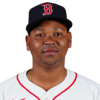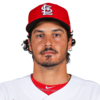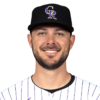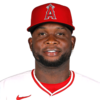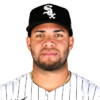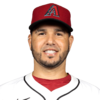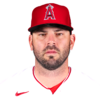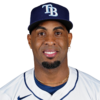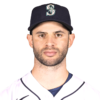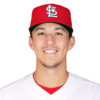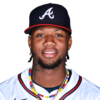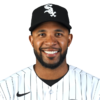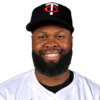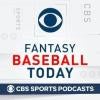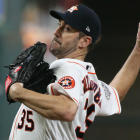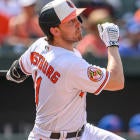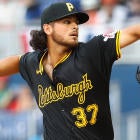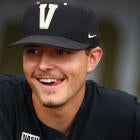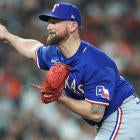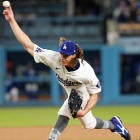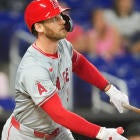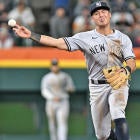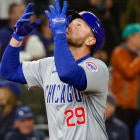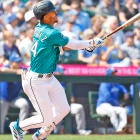We've arrived at a crossroads in Rotisserie play.
Increasingly, Major League Baseball has become a game of extremes. There are numerous reasons for it, but I can mostly explain it with two. Our collective research, wisdom and experience has revealed that the most valuable thing a hitter can do is hit the ball out of the park and the most valuable thing a pitcher can do is prevent contact in the first place.
So that's how they're coming out of the factory now, these hitters and pitchers. And for the ones that fall short, there's a fly-ball revolution in the works or a Driveline Baseball training regimen in development.
These trends were already beginning to reveal themselves, and then came the juiced ball midway through 2016. And then came the even jucier ball just last year. Those changes, whether intentional or not, leaned further into the trends, amplifying them to a level that has fundamentally changed the way the game is played.
Maybe it's unfair to characterize the balls as "juiced." Maybe it is just "manufacturing variability", as MLB calls it, with academic studies to back it up. But if that's their stance, it means they're probably not making a conscious decision to change it this year, which means everything we've witnessed over the past few years is just the reality we're faced with.
Specifically, this:
Home runs 👆 | Strikeouts 👆 | Stolen bases 👇 | |
2014 | 4,186 | 37,441 | 2,764 |
2015 | 4,909 | 37,446 | 2,505 |
2016 | 5,610 | 38,982 | 2,537 |
2017 | 6,105 | 40,104 | 2,527 |
2018 | 5,585 | 41,207 | 2,474 |
2019 | 6,776 | 42,823 | 2,280 |
Oh yeah. There be changes all right.
Extreme outcomes require extreme solutions, and the Fantasy-playing world seems to be catching on, specifically buying into the idea that stolen bases and high-end starting pitchers are in such demand that they're basically the game's only currency.
Must I prove it? You're insisting I must.
(Note: All references to average draft position, otherwise known as ADP, are according to FantasyPros' composite data.)
What it means for hitters
What it means for hitters is that everybody who's anybody hits home runs in some measure. When breaking down players, as Chris Towers and I did in depth recently, it's almost not even worth commenting on the power potential, apart from a few extreme cases, because power is presumed to be part of every player's profile. An astonishing 58 players hit 30-plus home runs last season, up from 11 as recently as 2014, and that's not even including certifiable early-rounders like Mookie Betts, Javier Baez and Aaron Judge.
When you remove what has historically been one of the greatest differentiators in player ability, everybody ends up looking the same. That's some mild hyperbole, but the range of possible hitter outcomes is quite obviously lessened, making it difficult to gain an advantage apart from the couple dozen surefire elites. And since the baseline for an acceptable hitter has universally improved, it's difficult to be at a real disadvantage either.
I'll use third base as an example, with Head-to-Head points per game as the standard for comparison. True, that format doesn't inflate the value of stolen bases the way traditional 5x5 scoring does, but since third base is largely free of base-stealers, it makes for a meaningful enough way to evaluate the sum of a player's contributions.
At the top last year were the four you can expect to go in the first two rounds this year:
| 2019 PPG | 2020 ADP | |||
|---|---|---|---|---|
Anthony Rendon
LAA 3B
| 4.30 | 20 | ||
Alex Bregman
HOU 3B
| 4.22 | 13 | ||
Rafael Devers
BOS 3B
| 3.87 | 26 | ||
Nolan Arenado
COL 3B
| 3.78 | 10 |
Then come the flukes — the players who, judging by ADP, no one is expecting to repeat last year's numbers:
| 2019 PPG | 2020 ADP | |||
|---|---|---|---|---|
DJ LeMahieu
NYY 2B
| 3.68 | 58 | ||

Yuli Gurriel
HOU 1B
| 3.55 | 130 |
And then comes a deluge:
| 2019 PPG | 2020 ADP | |||
|---|---|---|---|---|
Jose Ramirez
CLE 3B
| 3.43 | 19 | ||
Max Muncy
LAD 2B
| 3.41 | 70 | ||
Jeff McNeil
NYM 2B
| 3.40 | 85 | ||
Eduardo Escobar
ARI 3B
| 3.38 | 109 | ||
Kris Bryant
CHC 3B
| 3.35 | 43 | ||
Miguel Sano
MIN 3B
| 3.35 | 113 | ||
Josh Donaldson
MIN 3B
| 3.31 | 89 | ||
Yoan Moncada
CHW 3B
| 3.23 | 68 | ||
Eugenio Suarez
CIN 3B
| 3.20 | 78 | ||
Matt Chapman
OAK 3B
| 3.20 | 87 | ||
Mike Moustakas
CIN 3B
| 3.17 | 97 | ||
Yandy Diaz
TB 3B
| 3.10 | 255 | ||
Justin Turner
LAD 3B
| 3.08 | 147 | ||
Tommy La Stella
LAA 2B
| 3.05 | 288 | ||
Tommy Edman
STL 3B
| 3.04 | 138 | ||
Hunter Dozier
KC 3B
| 3.01 | 176 |
You see what I'm talking about? The 16 in the last tier were basically the same player, at least on a per-game basis. Sure, we could point to particular things some did better than others, but just assessing the sum of their contributions, the difference was virtually nothing. When you consider that half a point per game is all that separated Rendon from Arenado a couple tiers higher, it wouldn't take much to completely inverse the order of this larger tier, warping the concept of what a star is at what's regarded as one of the most start-studded positions.
What, then, are you actually paying up for? In the first two rounds, it's obvious, but beyond that, it mostly boils down to degrees of confidence.
And yes, some of those third basemen will falter, but in an environment where it's so easy to cultivate power, plenty will emerge that we don't even see coming. Who was making a hefty investment DJ LeMahieu, Yuli Gurriel, Jeff McNeil, Eduardo Escobar, Josh Donaldson, Yandy Diaz, Tommy La Stella, Tommy Edman or Hunter Dozier at this time last year?
And that's just sticking with the third base crop. Combining all hitters, the number that scored between 3.00 and 3.50 points per game last year (which was roughly the difference between Christian Yelich and Cody Bellinger, who are regarded as near equals early in the first round) was about 60.
When you account for all the other players being drafted, including pitchers, rookies, breakthrough candidates, bounce-back candidates and virtually every catcher, those 60 could span as many as 15 rounds. And those 15 rounds, remember, wouldn't be 1 through 15 since we're excluding the true elites. It would be something more like 4 through 19 or 5 through 20, even.
Depending on the depth of your league, then, the draft could conceivably end before all the quality hitters are taken — and again, that's only counting the ones we do see coming.
So when it comes to hitters, while there may be a particular skill scarcity (ahem, stolen bases), there is no shortage of able bodies.
What it means for pitchers
What it means for pitchers is that the ones we're seeing today are some ball-spinning freaks the likes of which the game has never known. They have to be to miss bats at the rate necessary to survive such an inhospitable environment. The ones who do survive fall into two categories: Either they're genuinely dominant because the talent level is so high or they're able to fake dominance because they pitch in shorter spurts. It's the age of specialization, as you know.
There is a third category of starting pitcher, and it's the most common one in the game today: They don't actually have the skills or stuff to navigate today's home run environment, but they'll take the ball every fifth day just because somebody has to. And those are the ones getting shellacked.
It makes for a chasm in the draftable pitcher ranks — one that's clearly defined but difficult to put into words. There are the haves and the have-nots, with maybe a dozen undecideds who offer hope of scaling that wobbly bridge in between.
Points per game | Number of pitchers, 2019 |
15+ | 26 |
12-14.9 | 28 |
10-11.9 | 45 |
The haves have already shown they can dominate over a starter's workload, throwing six-plus innings with regularity. While they aren't small in number (the table above shows 26, but I'll include about a dozen from the second group who underachieved for one reason or another, bringing it to about 40), they aren't abundant enough to stock every roster in a Fantasy league. And considering the enormity of the drop-off, the competition for their services is great, with an astonishing 23 starting pitchers being taken in the first 72 picks — or what would amount to the first six rounds of a 12-team draft.
The Fantasy GMs who get left out — and by that, I mean any openings remaining on their pitching staff — will spend the year cycling through bad options on the waiver wire, which anyone who found himself in that spot last year will tell you is a nightmare from which you can't escape.
What it means for base-stealers
What it means for base-stealers is they're a dying breed. When so many home runs are being hit, there's little incentive to risk an out on the base paths, especially since it's so often a source of injury. The players who run the most tend to be among the few who don't offer much power, thus impeding your team's ability to keep pace in a category set to overdrive. The number of usable base-stealers, then, is scarcer than ever, which makes for outsized demand in leagues where stolen bases are of inflated significance (such as the traditional 5x5 scoring format, be it Rotisserie or Head-to-Head).
This isn't altogether new, of course, but the continued decline last year seems to have brought us to a breaking point. People pursue these players with such fervor now that, for a while, I was calling it "stolen base derangement syndrome." But I've since taken part in enough Rotisserie drafts to share in the desperation. It is real, and it is to be feared.
Here's where last year's 20-steal guys are being drafted on average:
| 2020 ADP | ||||
|---|---|---|---|---|
Ronald Acuna
ATL CF
| 1 | |||
Christian Yelich
MIL RF
| 3 | |||
Francisco Lindor
CLE SS
| 8 | |||
Trevor Story
COL SS
| 9 | |||
Trea Turner
WAS SS
| 11 | |||
Jose Ramirez
CLE 3B
| 19 | |||
Starling Marte
ARI CF
| 29 | |||
Adalberto Mondesi
KC SS
| 45 | |||
Whit Merrifield
KC 2B
| 47 | |||
Jonathan Villar
MIA 2B
| 52 | |||
Victor Robles
WAS CF
| 76 | |||

Tommy Pham
SD LF
| 80 | |||
Danny Santana
TEX 1B
| 133 | |||
Elvis Andrus
TEX SS
| 152 | |||
Mallex Smith
SEA CF
| 170 | |||
Kolten Wong
STL 2B
| 220 | |||

Dee Gordon
SEA 2B
| 284 | |||
Jarrod Dyson
PIT CF
| 408 | |||
Delino DeShields
CLE CF
| 450 | |||
Manuel Margot
TB CF
| 455 | |||
Billy Hamilton
SF CF
| 547 |
You see how they just ... disappear? The ones drafted at 150 or later are basically desperation plays given how little they have to offer otherwise. True, some of the players we're expecting to contribute 20 or more steals this year didn't make this list — guys like Fernando Tatis, Cavan Biggio, Tim Anderson, Tommy Edman and Garrett Hampson — but even if you include them, it amounts to only a couple dozen viable contributors to an entire category.
Particularly since it's all the more difficult to distinguish yourself in the other hitter categories — at least in a way you can reasonably predict at a time when everybody's hitting home runs — you can't afford to punt on this one. But unless you're willing to go against your instincts and reach for a riskier and altogether inferior player who just so happens to run a little, it'll happen. Waiting for a base-stealer to fall to you is a fool's endeavor.
What it means for you
What it means for you is that you need to attack the draft with a narrow focus and clear understanding that you'll have to do things that make you uncomfortable — things that defy your instincts and betray your wealth of experience.
Take it from a guy who's already been there several times over: The jig is up. Lessons were learned last year. Too many of us shared the experience of having too many hitters to start but no one in need of the excess, of clinging desperately to our aces even while the most pitching-rich team in the league came knocking for them. The game's recent tendency toward extremes isn't going away but instead becoming more intense.
However hard you think you have to go after stolen bases (in the formats where they specifically matter, anyway) and high-end starting pitchers isn't hard enough because everyone is on the same page: They're all that matter anymore. They're the only real currency in a league overrun with bats — the only places where you can gain a real advantage and, perhaps more critically, the only ones where you can be left out to dry.
Even a zig-while-everyone-else-zags approach would be difficult to justify because nothing you can realistically do would guarantee you an advantage in those other categories. The hitters capable of high-end production are too plentiful and too likely to spring out of nowhere. What does paying up for Kris Bryant do for you when there's a Trey Mancini or J.D. Davis lurking in the shadows? And seeing as no one was really onto those two last year — or Josh Bell or Marcus Semien or Austin Meadows, Jorge Soler or Jorge Polanco — imagine all the stud bats we won't see coming this year.
The hitters will always be there, at least in a typical mixed league. The base-stealers and impact pitchers will run out. Even if they seem riskier, even if they're more likely to bust on an individual level, they're where your focus needs to be in the early stages of the draft, as aggressively as you can stomach it, up to the point they're all gone.
They're the only currency in today's game, which means you'll have nothing to offer anyone else if you didn't take enough for yourself at the start.
So which sleepers should you snatch in your draft? And which undervalued first baseman can help you win a championship? Visit SportsLine now to get rankings for every single position, all from the model that called Kenta Maeda's huge breakout last season, and find out.









